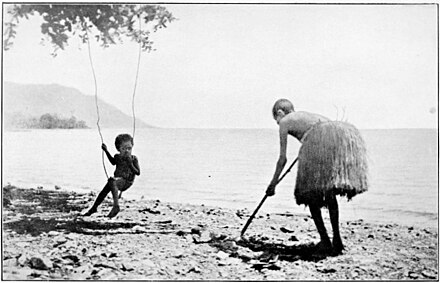PAPUAN FAIRY TALES

MACMILLAN AND CO., Limited
LONDON · BOMBAY · CALCUTTA
MELBOURNE
THE MACMILLAN COMPANY
NEW YORK · BOSTON · CHICAGO
ATLANTA · SAN FRANCISCO
THE MACMILLAN CO. OF CANADA, Ltd.
TORONTO
PAPUAN
FAIRY TALES
BY
ANNIE KER
WITH ILLUSTRATIONS
MACMILLAN AND CO., LIMITED
ST. MARTIN'S STREET, LONDON
1910
GLASGOW: PRINTED AT THE UNIVERSITY PRESS
BY ROBERT MACLEHOSE AND CO. LTD.
CONTENTS
ILLUSTRATIONS
| The Talking Bananas | Frontispiece |
| The Jungle Boy | 21 |
| Kakukaku and Taureboga | 36 |
| How Wakeke defeated Arebo | 41 |
| The Wise Wagtail | 45 |
| Why the Men of Gavi will not eat Fish | 52 |
| Manubada's Bride | 57 |
| How the Twins killed Manubada | 61 |
| The Crane | 64 |
| Toroa, the Song of the Dead | 68 |
| Dakodako, the Man Eater | 84 |
| The Magic Almonds | 86 |
| The Three Sisters | 147 |
INTRODUCTION.
The following fairy tales were collected chiefly from the natives of a small village on the N.E. coast of Papua. I have known these people for nine years, and for part of that time lived alone amongst them in a little mission bungalow.
Sometimes when seated on the verandah, with a group of children around me, I would entice an old woman to narrate for our amusement some such story as the adventures of the Turtle and the Wallaby, or the cruel fate which befell the child left to the care of the Talking Bananas.
Nothing loth, the old crone would patter out the tale which she had heard from her grandmother, who in turn had learnt it at some greybeard's knee. There was generally a little incantation or magic verse in each story, and this was invariably chanted to an air which one might call the fairy tale motif, for it appeared with great regularity, linked however to very diverse words.
In the village at night, when the "moon was dead," young married couples sitting in the dark would tell these stories turn and turn about to each other; some village dogara (elder) would have a group listening intently to his tale told over a smoking fire lit in the open; and in the men's club-house reclining forms would woo sleep to the sound of still another of these folk-tales recounted by a more wakeful one of their number.
But, as amongst the primitive tribes of Papua no written record whatever exists of these ancient stories, it was thought well to preserve in a more lasting form some at least of the vanishing store, for the older generation is fast dying out, and the young folk, now in touch with the white man, cannot be expected to treasure the old lore as did their fathers.
So natives who heard there was a white woman who would give tobacco for "Virarautua" (folk-lore) came in companies, and seated on the ground before me told at length and with much repetition the tales which follow. If their memory failed them on any point, or I wished for further elucidation, the narrator referred the disputed matter to some patriarch, who settled it dogmatically for us.
The tales exhibit to a marvellous degree the Papuan outlook upon life. What could be more characteristic of the native temperament than the action taken by Kakukaku and Taureboga when their sister Rekota's slighting remarks were repeated to them? No self-respecting Papuan would think it worth while to survive the insult. Hence their self-immolation.
Sorcerers and witches, who play so great a part in the stories, are a very real feature in Papuan life to-day. I have met many in different villages, and claim several as my friends. No doubt some years ago they would have been dealt with summarily by infuriated villagers, but now the law is feared, the witch is propitiated by gifts of food. All deaths, however, save those due to accident, are laid to her charge, and quite an ordinary remark on hearing of a death is "Who killed him?" meaning which witch?
Cannibalism, too, is another important feature. This practice is still indulged in by tribes out of reach of the Government, and there are many of the coastal tribes who, having had to relinquish the habit, still sigh for the good old days "when there was plenty to eat." It is not therefore surprising that many of the stories deal with cannibal practices.
![]()
This work is in the public domain in the United States because it was published in 1910, before the cutoff of January 1, 1929.
The longest-living author of this work died in 1945, so this work is in the public domain in countries and areas where the copyright term is the author's life plus 78 years or less. This work may be in the public domain in countries and areas with longer native copyright terms that apply the rule of the shorter term to foreign works.
![]()
Public domainPublic domainfalsefalse
